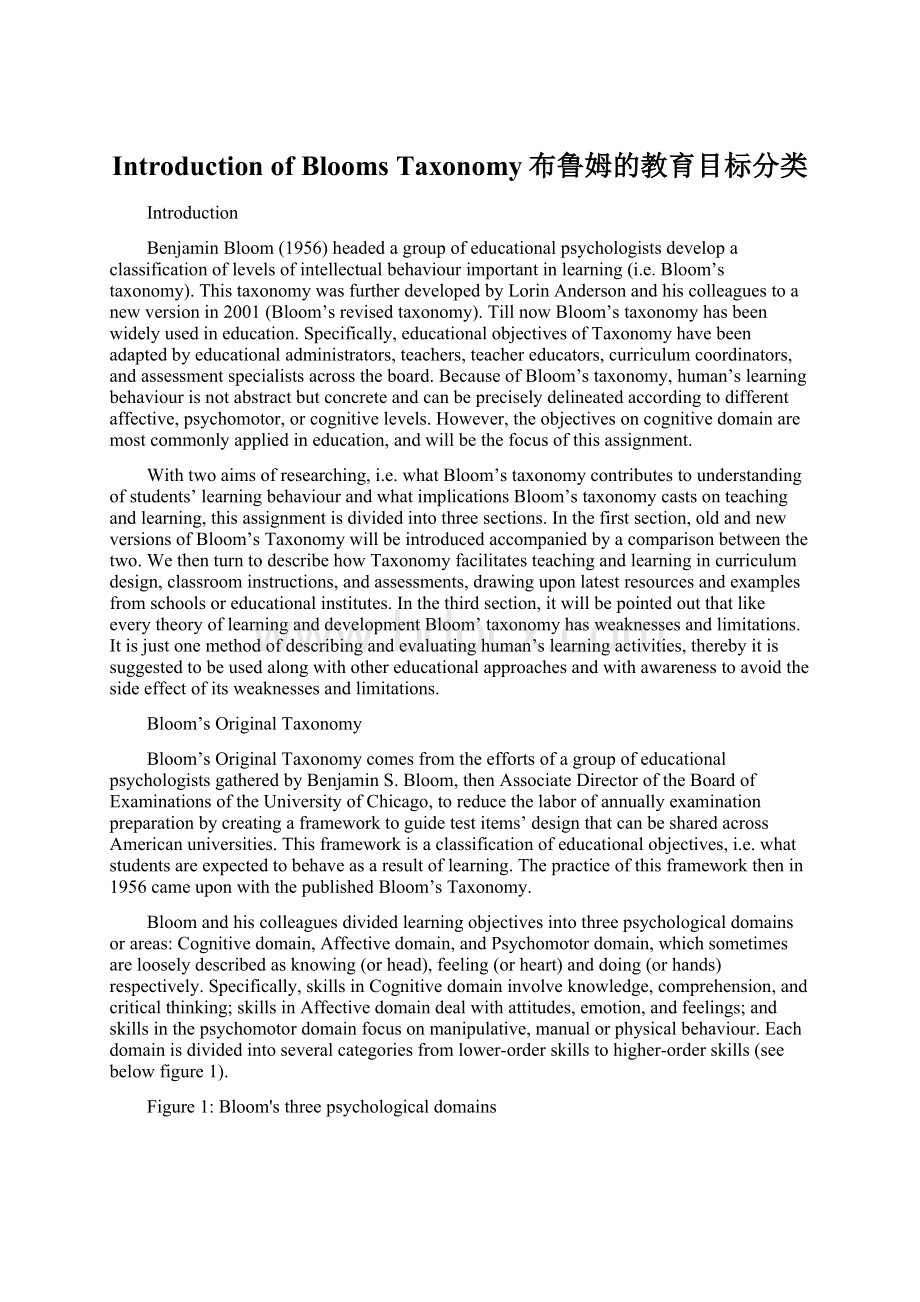 Introduction of Blooms Taxonomy布鲁姆的教育目标分类Word文件下载.docx
Introduction of Blooms Taxonomy布鲁姆的教育目标分类Word文件下载.docx
- 文档编号:18441976
- 上传时间:2022-12-16
- 格式:DOCX
- 页数:13
- 大小:224.43KB
Introduction of Blooms Taxonomy布鲁姆的教育目标分类Word文件下载.docx
《Introduction of Blooms Taxonomy布鲁姆的教育目标分类Word文件下载.docx》由会员分享,可在线阅读,更多相关《Introduction of Blooms Taxonomy布鲁姆的教育目标分类Word文件下载.docx(13页珍藏版)》请在冰豆网上搜索。

Bloom’sOriginalTaxonomycomesfromtheeffortsofagroupofeducationalpsychologistsgatheredbyBenjaminS.Bloom,thenAssociateDirectoroftheBoardofExaminationsoftheUniversityofChicago,toreducethelaborofannuallyexaminationpreparationbycreatingaframeworktoguidetestitems’designthatcanbesharedacrossAmericanuniversities.Thisframeworkisaclassificationofeducationalobjectives,i.e.whatstudentsareexpectedtobehaveasaresultoflearning.Thepracticeofthisframeworkthenin1956cameuponwiththepublishedBloom’sTaxonomy.
Bloomandhiscolleaguesdividedlearningobjectivesintothreepsychologicaldomainsorareas:
Cognitivedomain,Affectivedomain,andPsychomotordomain,whichsometimesarelooselydescribedasknowing(orhead),feeling(orheart)anddoing(orhands)respectively.Specifically,skillsinCognitivedomaininvolveknowledge,comprehension,andcriticalthinking;
skillsinAffectivedomaindealwithattitudes,emotion,andfeelings;
andskillsinthepsychomotordomainfocusonmanipulative,manualorphysicalbehaviour.Eachdomainisdividedintoseveralcategoriesfromlower-orderskillstohigher-orderskills(seebelowfigure1).
Figure1:
Bloom'
sthreepsychologicaldomains
CognitiveskillsAffectiveskillsPsychomotorskills
However,Bloomisbestknownfortheresearchincognitivedomain.Inthisdomain,cognitiveprocesseswereclassifiedintosixcategories,i.e.Knowledge,Comprehension,Application,Analysis,Synthesis,andEvaluation.Theyarearrangedinacumulativehierarchy,whichmeansthemasteryofsimplethinkingskillsisrequiredpriortothemasteryofcomplexones.Furthermore,eachmaincategorywasbrokenintosubcategoriesexceptApplication.
Withitspreciseclassificationofeducationalobjectives,Bloom’staxonomymakesitpossibleforteachingcontentandprocesstobeformulated.Italsoprovidesaconvenientandobjectivemeasurementforlearningbehaviours,whichishelpfulinenhancingeducationalquality.
Afterhavingbeenputintopracticefor45years,Bloom’staxonomy,however,hasrevealedweaknessesandlimitations,thusin2001,anewgroupofcognitivepsychologists,educationalresearchersandtestingspecialistsledbyBloom’sformerstudentLorinAndersonupdatedthetaxonomytoarevisedversion.Bloom’srevisedtaxonomydrewonrecenteducationalandpsychologicaldevelopmentinthe21stcenturyandmadeitamorecompleteandpracticaleducationalmethod.Detailswillbegiveninthenextsection.
Bloom’srevisedtaxonomy
Therevisedtaxonomywasdevelopedinmuchthesamemannerastheoriginalone.Itretainedthesamenumber(i.e.six)ofcognitiveprocessesandkeptsomeoftheoriginalknowledgesubjects.However,12changeshavebeenmadeinemphasis,structureandterminology,andsomechangesaresignificantandwillbediscussedbelow.
Firstly,withrespecttoemphasis,therevisedtaxonomyaimstoserveawiderangeofteachers,notonlyhighereducationteachers,whoarefocusoftheoriginaltaxonomy,butalsothosefromelementaryandsecondaryeducation,thusitaddedexamplesfromfundamentaleducation.Anotherimportantshiftofemphasiswasfromservingexaminationstothetaxonomyinuse,i.e.theoriginaltaxonomyfocusedonassessmentsbyprovidingabundantexamplesoftestitemswhereastherevisedtaxonomygivesmanyexamplesofhowthetaxonomyisusedincurriculumdesign,instruction,assessmentandthealignmentofthethree.Inaddition,comparingwiththeoriginaltaxonomyinwhichthesixmajorcategoriesweregivenfarmoreattentionthanthesubcategories,therevisedversiondescribedthelatterindetail.Thisindeedcouldhelpteachersunderstandthenatureofthesixmajorcategoriesmoreclearly(Krathwohl,2002).
Second,intermsofterminology,atfirst,thesixmajorcategorieswerechangedfromnounstoverbs(seefigure2).Specifically,KnowledgeandComprehensionwererenamedtoRememberandUnderstand,SynthesiswasretitledtoCreate,whilstApplication,AnalysisandEvaluationwerechangedtotheirverbformsApply,Analyse,andEvaluate.Thenthesubtypesofeachcategorywereallreplacedbytheirgerunds,calledas‘cognitiveprocesses’(Andersonedal.,2001,p64),tosuitthewayinstructionsareusedbyteachers,takeAnalyzeforexample,intheoriginalversion,itisAnalysisconsistingofAnalysisofelements,AnalysisofrelationshipsandAnalysisoforganizationalprinciples,whileintherevisedversionitturnedtobeAnalyzewithsubcategoriesDifferentiating,OrganizingandAttributing.
Figure2:
AcomparisonbetweentheOriginalTaxonomyandtheRevisedTaxonomy
OriginalTaxonomy
RevisedTaxonomy
Thethirdtypeandalsothemostsignificantchangesareinstructure.
1)Fromonedimensiontotwodimensions
Ashasbeenmentionedabove,Bloom’srevisedtaxonomyhasintegratedthelatestresearchoneducationandpsychology(e.g.Constructivism,Self-regulatedlearning,andMetacognition)in21stCentury,mostofwhichemphasizelearners’roleindevelopmentandassumedthatlearnersthemselvesareactivelyinvolvedintheprocessesoflearning.AsAndersonedal.(2001,p38)putit‘‘passiveviewsoftakinglearnersas‘passiverecipients’and‘informationrecorders’hadbeenshiftedtowardsmorecognitiveandconstructivistperspectivesemphasizeswhatlearnersknow(knowledge)andhowtheythink(cognitiveprocess)’’;
therefore,inBloom’srevisedtaxonomy,thecategorizationofobjectiveshasbeenchangedfromonedimensiontotwo-dimensions:
KnowledgeDimensionandCognitiveDimension(seetable1).
Table1:
TheTwoDimensionalTaxonomyTable
TheCognitiveProcessDimension
TheKnowledge
Dimension
1.Remember
2.Understand
3.Apply
4.Analyze
5.Evaluate
6.Create
A.Factual
Knowledge
B.Conceptual
C.Procedural
D.Metacognitive
2)Knowledgedimension
Intheoriginaltaxonomy,Knowledgeactuallypossessesbothnounandverbaspects,thenounaspectwasshowninits9subcategoriesandtheverbaspectwasexplainedinitsdefinition(i.e.recallorrecognize),butinthestructureoftheoriginaltaxonomy,theKnowledgecategorydisplaysonlynounaspect,say,subcategorieslikeKnowledgeofspecificfacts,Knowledgeofclassificationsandcategories.However,theotherfivemajorcategoriesallshowverb-nounrelationship,say,subcategorieslikeAnalysisoforganizationalprinciples,Productionofaplan,orproposedsetofoperations.Moreover,inteachingreality,instructionalobjectivesareusuallyformulatedbytwoparts:
somesubjectmattercontentandadescriptionofthedeedtothatcontent(Amer,2006).SotherevisedtaxonomyrectifiedthissituationbyseparatingthenounroleofKnowledgetoanewdimensionKnowledgeDimension.
Fromtable1,itcouldalsobeenseenthatanewKnowledgecategory‘Metacognitiveknowledge’hasbeenaddedintotheKnowledgedimension.Asithasbeenmentionedabove,therevisedtaxonomyhadbeeninfluencedbyrecenteducationaldevelopment,thisMetacognitiveknowledgecomesfromMetacognitionwhichisassumedtobe‘cognitionaboutcognition’(Flavell,1985,p.104).OneimportantassumptiononMetacognitionisthatitconsistsoftwocomponents,thefirscomponentisknowledgeaboutwhatskills,strategiesandresourcesarerequiredtocompleteatask(Schunk,2008),whereasthesecondinvolvesprocessesonhowandwhentoapplytheformer‘cognitiveknowledge’tosuccessfullycompleteatask(Pintrich,2002),thusitcouldbeinferredthatMetacognitiveknowledgecorrespondtotheKnowledgeDimensionandCognitiveDimensionofthetaxonomyTablerespectively.
3)CognitiveDimension
WithrespecttothestructureoftheCognitiveDimension,thetoptwohigher-orderprocesseswereinterchanged,placingCreateahigherlevelth
- 配套讲稿:
如PPT文件的首页显示word图标,表示该PPT已包含配套word讲稿。双击word图标可打开word文档。
- 特殊限制:
部分文档作品中含有的国旗、国徽等图片,仅作为作品整体效果示例展示,禁止商用。设计者仅对作品中独创性部分享有著作权。
- 关 键 词:
- Introduction of Blooms Taxonomy布鲁姆的教育目标分类 Taxonomy 布鲁姆 教育 目标 分类
 冰豆网所有资源均是用户自行上传分享,仅供网友学习交流,未经上传用户书面授权,请勿作他用。
冰豆网所有资源均是用户自行上传分享,仅供网友学习交流,未经上传用户书面授权,请勿作他用。
链接地址:https://www.bdocx.com/doc/18441976.html


 转基因粮食的危害资料摘编Word下载.docx
转基因粮食的危害资料摘编Word下载.docx
